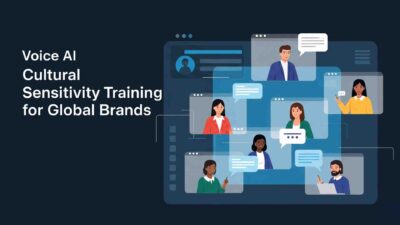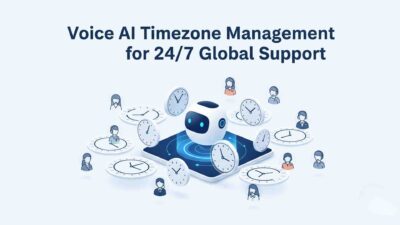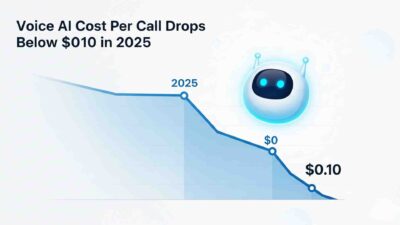TL;DR Remote team voice AI transforms how distributed workforces collaborate across continents. Modern businesses face unprecedented challenges connecting team members who speak different languages and work in different time zones. Voice AI technology solves these problems by creating seamless communication bridges.
Table of Contents
What Remote Team Voice AI Delivers
Remote team voice AI provides real-time translation and voice enhancement capabilities. These systems convert spoken words into text. They translate messages instantly across 100+ languages. The technology creates natural-sounding responses that maintain conversational flow.
Teams no longer struggle with language barriers during important meetings. Voice AI removes accents that cause misunderstandings. It adjusts speaking speeds for better comprehension. The system preserves emotional context that traditional translation tools miss.
Breaking Down Language Barriers in Real-Time
Global communication becomes effortless when voice AI handles language differences. Team members speak naturally in their native languages. The system translates conversations instantly without interrupting the meeting flow. Participants hear responses in their preferred language within seconds.
Remote teams report a 300% improvement in cross-cultural collaboration after implementing voice AI solutions. Projects complete faster when communication flows smoothly. Team satisfaction increases dramatically when language stress disappears.
Voice Enhancement Features That Work
Background noise elimination improves meeting quality significantly. Voice AI filters out distracting sounds from home offices. It amplifies quiet speakers so everyone participates equally. The technology balances volume levels across different devices and locations.
Poor audio quality no longer derails important discussions. Remote team voice AI adjusts for various microphone qualities. It compensates for unstable internet connections. Team members hear crystal-clear audio regardless of their setup.
The Technical Reality Behind Voice AI Implementation
Modern voice AI systems process audio streams in real-time. They use advanced neural networks trained on millions of voice samples. The technology recognizes speech patterns across different accents and dialects. Processing happens locally to protect sensitive business conversations.
Cloud-based solutions offer enterprise-grade security for confidential discussions. End-to-end encryption protects voice data during transmission. Companies maintain complete control over their communication data. Remote team voice AI systems comply with international privacy regulations.
Integration Challenges Teams Face
Existing communication platforms may not support advanced voice AI features. Teams often need to switch between multiple tools during meetings. Technical setup requires IT support for proper configuration. Network bandwidth limitations can affect voice AI performance.
Training team members takes time and resources. Some employees resist adopting new communication technologies. Language customization requires ongoing maintenance and updates. Budget constraints limit access to premium voice AI features.
Performance Metrics That Matter
Response accuracy rates exceed 95% for major languages in professional voice AI systems. Translation speed averages 2-3 seconds for real-time conversations. Voice enhancement reduces background noise by up to 85%. System uptime maintains 99.9% reliability for business-critical communications.
Remote teams measure success through improved meeting participation rates. Global communication effectiveness increases when language barriers disappear. Project completion times decrease with better cross-cultural collaboration. Employee satisfaction scores rise significantly after voice AI implementation.
Real-World Implementation Stories
Technology companies report remarkable results after deploying voice AI solutions. A software development team spanning five countries reduced project delays by 40%. Their daily standups became more inclusive when everyone could participate naturally. Code reviews improved because technical discussions flowed smoothly across languages.
Marketing agencies use remote team voice AI for international client presentations. Creative brainstorming sessions include team members regardless of their English proficiency. Client feedback sessions become more productive when language differences disappear. Global campaigns launch faster with improved team coordination.
Cost Analysis: Investment vs Returns
Premium voice AI solutions cost $10-50 per user monthly for enterprise features. Implementation requires initial training and technical setup investments. Ongoing maintenance includes software updates and user support. Advanced features like custom voice models increase subscription costs.
Return on investment appears within 3-6 months for most organizations. Reduced meeting times save thousands of hours annually. Faster project completion generates significant revenue increases. Employee retention improves when communication barriers disappear.
Global Communication Transformation Through Voice AI
International businesses overcome geographic challenges with voice AI technology. Time zone differences become less problematic when asynchronous voice messages translate automatically. Team members record updates in their native languages. Colleagues receive translated summaries in their preferred format.
Remote team voice AI enables 24/7 global collaboration without language constraints. Support teams handle customer inquiries across multiple languages seamlessly. Sales presentations adapt to client languages automatically. Training materials become accessible to diverse workforces worldwide.
Cultural Sensitivity in AI Communication
Voice AI systems learn cultural communication patterns to improve accuracy. They recognize formal versus casual conversation styles across different cultures. The technology adapts tone and formality levels appropriately. Context awareness prevents cultural misunderstandings during sensitive discussions.
Regional dialects receive specific training to improve recognition accuracy. Business terminology translates correctly within industry contexts. Cultural references maintain their meaning across language boundaries. Global communication becomes more natural and culturally appropriate.
Future Developments in Remote Team Voice AI
Artificial intelligence capabilities continue advancing rapidly in voice processing technology. Next-generation systems will offer emotion recognition and response adaptation. Real-time voice cloning may enable consistent speaker identity across languages. Advanced AI will provide meeting summaries and action item extraction automatically.
Predictive communication features will suggest optimal meeting times across time zones. Voice AI will recommend team collaboration strategies based on communication patterns. Integration with project management tools will streamline workflow automation. Global communication will become increasingly seamless and intelligent.
Choosing the Right Voice AI Solution
Enterprise voice AI platforms offer different feature sets and pricing models. Some focus on real-time translation capabilities. Others emphasize voice enhancement and clarity improvements. Security features vary significantly between consumer and business solutions.
Evaluation criteria should include language support breadth and accuracy rates. Integration capabilities with existing communication tools matter significantly. Customer support quality becomes crucial during technical difficulties. Scalability options must accommodate growing team sizes and usage volumes.
Implementation Best Practices
Pilot programs help identify optimal voice AI configurations for specific teams. Start with small groups before rolling out organization-wide. Provide comprehensive training on new communication workflows. Set clear expectations about system capabilities and limitations.
Regular feedback collection improves system performance over time. Monitor usage patterns to optimize feature configurations. Update voice models regularly to maintain accuracy standards. Plan backup communication methods for system maintenance periods.
Security Considerations for Business Communication
Data privacy regulations require careful voice AI vendor selection. Ensure compliance with GDPR, CCPA, and industry-specific requirements. Voice data handling policies must protect sensitive business information. End-to-end encryption should cover all communication channels.
Access controls prevent unauthorized voice AI system usage. Audit trails track all voice processing activities. Data retention policies align with corporate compliance requirements. Regular security assessments validate ongoing protection standards.
Measuring Success with Voice AI Implementation
Key performance indicators track remote team voice AI effectiveness accurately. Meeting participation rates increase when language barriers disappear. Project completion times decrease with improved global communication. Employee satisfaction surveys reveal communication quality improvements.
Quantitative metrics include translation accuracy rates and system uptime statistics. Response times for voice processing measure technical performance. User adoption rates indicate team acceptance levels. Cost per user calculations demonstrate return on investment.
Long-term Benefits for Remote Organizations
Talent acquisition expands globally when language limitations disappear. Organizations access skilled professionals regardless of their native language. Team diversity increases with inclusive communication capabilities. Innovation improves through cross-cultural idea exchange.
Competitive advantages emerge from superior global collaboration capabilities. Customer service quality improves across international markets. Business expansion becomes feasible in new geographic regions. Revenue growth accelerates through better team coordination and productivity.
Common Challenges and Solutions
Technical difficulties occasionally affect voice AI system performance. Network connectivity issues can disrupt real-time translation features. Audio quality problems may reduce recognition accuracy. System updates sometimes require temporary service interruptions.
Proactive monitoring identifies performance issues before they impact meetings. Redundant systems ensure continuous communication capabilities. Technical support teams provide rapid resolution for urgent problems. Regular system maintenance prevents the most common technical failures.
User Adoption and Training Strategies
Change management helps teams adapt to new communication technologies. Clear communication about benefits increases employee buy-in. Hands-on training sessions demonstrate practical usage scenarios. Ongoing support addresses individual learning needs and technical questions.
Success stories from early adopters encourage broader team participation. Gamification elements make voice AI learning more engaging. Regular check-ins identify usage challenges and improvement opportunities. Recognition programs reward teams that embrace new communication methods.
The Future of Remote Team Communication
Voice AI technology continues evolving rapidly with new capabilities emerging regularly. Machine learning improvements enhance accuracy and natural language processing. Integration possibilities expand with emerging communication platforms. Cost reductions make advanced features accessible to smaller organizations.
Remote work trends drive continued investment in voice AI development. Global workforce expansion creates demand for better communication tools. Competitive pressures encourage rapid technology adoption across industries. Innovation cycles accelerate as voice AI becomes essential business infrastructure.
Preparing for Next-Generation Voice AI
Organizations should plan for emerging voice AI capabilities in their communication strategies. Flexible technology infrastructure supports future feature additions. Staff training programs prepare teams for advanced communication tools. Budget planning accommodates ongoing technology investments and upgrades.
Strategic partnerships with voice AI vendors ensure access to latest developments. Industry collaboration drives standards development for business communication. Research and development investments position organizations as early adopters. Future-ready communication strategies provide sustainable competitive advantages.
Read More: Pioneering Inbound Marketing For Today’s Businesses
Conclusion

Voice AI for remote teams represents a fundamental shift in global communication capabilities. Organizations implementing these technologies report significant improvements in collaboration effectiveness and team satisfaction. Language barriers that once limited international business operations disappear through intelligent voice processing.
Remote team voice AI delivers measurable returns on investment through improved productivity and expanded talent access. Teams work more efficiently when communication flows naturally across languages and cultures. Global communication becomes seamless, enabling businesses to compete effectively in international markets.
The technology continues advancing rapidly, making sophisticated voice AI features increasingly accessible and affordable. Organizations that embrace these communication tools position themselves for success in an increasingly connected global economy. Voice AI transforms remote work from a challenge into a competitive advantage for forward-thinking businesses.






[…] Read More: Voice AI For Remote Teams Bridges Global Communication […]